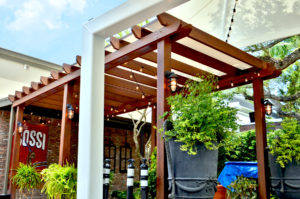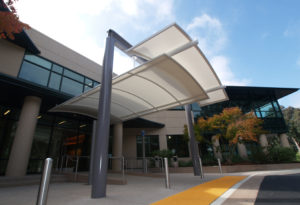 Fabric structure companies with metal shops make material decisions based on multiple factors.
Fabric structure companies with metal shops make material decisions based on multiple factors.
Site conditions, local building codes, aspects of design and customer preferences dictate the type of metal used with fabric structures, says Gerald Thompson, CEO of Awnings of Hollywood. His company works with high-strength steel pipe and tubing, aluminum pipe and tubing, and aluminum staple-on extrusions.
Once frames are assembled, Florida-based Awnings of Hollywood coats welds with a primer, then applies color or clear coating through a range of methods: hand finishing, spray gun, electrostatic spray painting, and powder coating.
“We present the customer with several options and allow them to decide what finish they would like us to use,” Thompson says. “On-site electrostatic painting is usually done for transportation of large structures after final erection and/or field welding has been completed.”
For St. Louis, Mo.-based Lawrence Fabric & Metal Structures Inc., 80 percent of frames are aluminum, 15 percent are cold steel, and the rest are stainless steel. “We don’t use stainless steel if the architect didn’t request it. Stainless steel is weaker than regular steel,” president Mike Bowman says. “We try to do everything we can out of aluminum. It’s usually the engineering that dictates when we move from aluminum to steel. Almost always, steel is required for support posts.”
“Our preference for aluminum is because we are good at it and it’s lighter weight for installers. It will not rust, so one frame will last 30 to 40 years without having an issue,” adds Jerry Grimaud, Lawrence’s former owner, who remains with the company during a transitional period.
“The customer usually does not have a preference between aluminum and steel until they hear the advantages of aluminum. Aluminum is less expensive to manufacture, which is their number one concern. We are able to engineer loads with aluminum. The customer just wants it to look nice, require less maintenance, and be on budget,” Bowman says.

Aesthetics, economics and engineering
Although aluminum doesn’t need to be painted, a lot of Lawrence’s framework is painted for aesthetic purposes. “We can do mill-finish aluminum, but we paint a lot of our frames because it is specified by the architect to be the same color as the fabric,” Grimaud says. The company outsources powder coating when architects specify that finish.
“Budgets usually dictate the customer’s request for steel or aluminum,” says Joe Belli, president of Eide Industries Inc. in Cerritos, Calif. “But engineering requirements also are a factor.”
Eide’s standard finish is smooth-finish powder coating. However, the company also offers textured powder coating, galvanizing, anodized aluminum and a three-part paint finish.
Canvas Designers Inc. of Riviera Beach, Fla., which specializes in marine products, works with aluminum and stainless steel. Occasionally, the company uses brass, copper and bronze in underwater parts or as decorative showpieces.
“The choice is widely determined by the application and the customer’s budget,” says Steve Eannarino, manager of the metal department. “For example, stainless steel grade 304 is less expensive than grade 316L. Both can be used in the same application; however, 304 will not hold up as well over time.” More often than not, the company uses grade 316L stainless steel because of its strength, corrosion resistance and ability to hold its shape and perform at high temperatures.
“We provide mill, brushed, polished, anodized, painted and galvanized finishes,” he adds. “Mirror-polished stainless steel is the most common.”
Miami Awning Co. of Miami, Fla., uses aluminum and galvanized steel pipe and tubing. “Sometimes the location of the project dictates it be made of aluminum—for instance, if it is to be installed near saltwater,” president Mike Reilly says. His company offers two finish options.
“Powder coating is more expensive and affects how the framing is made, since it needs to fit into the oven,” he says. “It also requires extra time and steps. Electrostatic spray painting is our most popular finish.”
The Bellon Prestige Group in Montreal, Canada, primarily uses aluminum. “We used to use galvanized steel. We still do if we replace parts,” president Carole Bellon says, adding that approximately once a year a client requests stainless steel.
“People are very happy to have aluminum, because it doesn’t rust. In Canada, everything rusts because of weather. We use more steel than aluminum in our winter shelters, because they are made differently and it ends up being cheaper with steel than aluminum.”
Lakeside Marine Canvas in Buford, Ga., primarily uses aluminum and applies a range of finishing methods, including mill finish, brushed anodized aluminum and powder coating. According to owner and president Daymon Johnstone, “99.99 percent is mill finished or anodized if it needs to be shiny.”
Janice Kleinschmidt is a writer and editor based in San Diego, Calif.
 TEXTILES.ORG
TEXTILES.ORG


